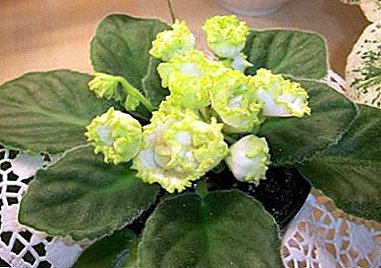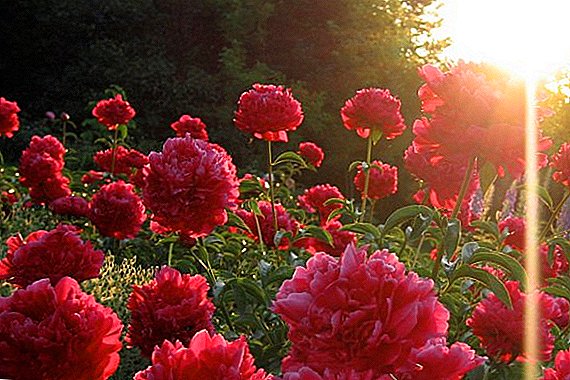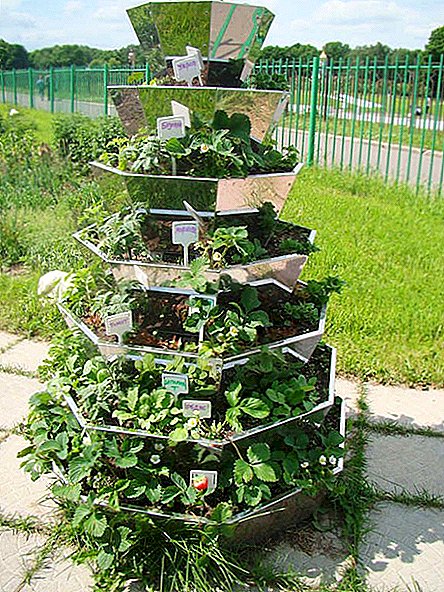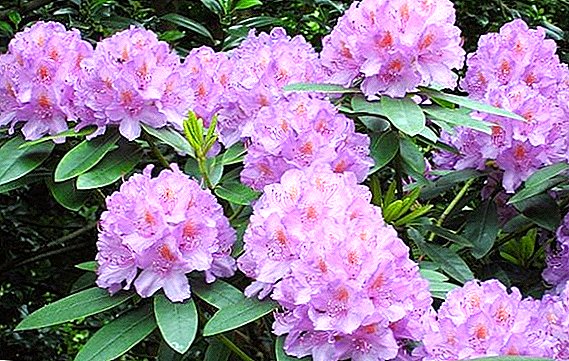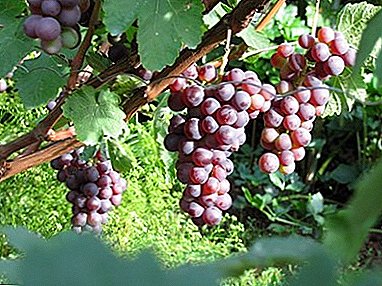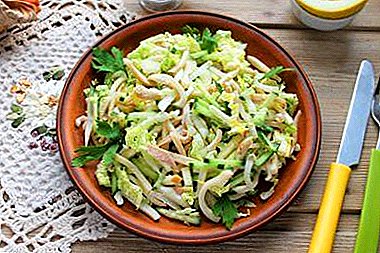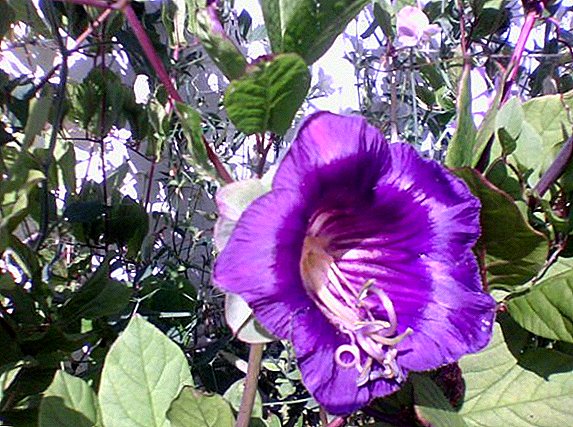 Kobeya - a guest from sunny Mexico who has grown fond of flower growers for their rapid growth and decorative appearance. This creeping vine with its tenacious tendrils braids any support and grows up to six meters.
Kobeya - a guest from sunny Mexico who has grown fond of flower growers for their rapid growth and decorative appearance. This creeping vine with its tenacious tendrils braids any support and grows up to six meters.
Her flowers in the form of bluebells delight with an abundance of colors: white, pink, purple, lilac and even burgundy.
Sowing Kobe seeds for seedlings
Kobeyu seeds are planted in February or the first days of March. In sowing the seeds of a plant there are certain nuances. Before sowing first soak Kobe seeds. Seeds of creepers are covered with a thick shell that impedes the emergence of shoots, this barrier must be dissolved and removed.
 To do this, take a container with a wide bottom, fill it with water, distribute the seeds so that there are no touches to each other, and cover with foil. Crust under the influence of water will begin to dissolve. Delete what is possible, and to completely get rid of the shell, the procedure will have to be repeated.
To do this, take a container with a wide bottom, fill it with water, distribute the seeds so that there are no touches to each other, and cover with foil. Crust under the influence of water will begin to dissolve. Delete what is possible, and to completely get rid of the shell, the procedure will have to be repeated.
Perhaps the process will take several days. But in this case, you will know for sure how long the Kobe will rise: this will happen in about two weeks.
After getting rid of the peel, start planting kobei on seedlings. It is best for the plant to purchase a universal primer. Sow seeds preferably in separate cups, so as not to damage the roots of shoots during transplantation. The seed is laid flat down and sprinkled with a layer of earth and a half centimeters.
Did you know? The shade of a flowering Kobe depends on the acidity of the soil: the greater the acidity index, the more red the shade in the petals of a bell. On calcareous soils, flowers are more often painted in blue and its tones.
Seedling care
Caring for seedlings is a bit problematic: on the one hand, seedlings for development need abundant watering, on the other - an excess of moisture can cause illness (black leg).

It is useless to cure this disease, in addition, nearby vases can be infected. Therefore, choose watering in the pan, and the soil is sometimes watered with a weak-pink manganese solution.
As soon as two leaves are planted on the seedlings, they can be transplanted into a large (3 liters) pot. To avoid injury to the root system, the seedling should be poured abundantly and taken out of the cup along with the earthy clod. Along with this lump of old soil we plant a kobay in a new pot and sprinkle it with soil.
Replacing in a large container, you give the plant the opportunity to develop the root system before transplanting into open ground. The roots will grow and get stronger, thus ensuring one hundred percent rooting in your area. Since it is a vine, she needs to put a mini ladder in a pot so that there is something to cling to.
Planting Kobe seedlings on the garden plot
Before planting, seedlings need to temper. Grown up shoots can be taken out on the glazed balcony in order not to freeze the plant. But do not overdo kobey - much expanded root system is easier to injure during transplantation.
Dates and choice of place for landing
 Landing Kobey in the ground carried out in Maywhen the temperature at night does not fall below +5 ºС. The site for the plant must be protected from the wind and not be strongly shaded.
Landing Kobey in the ground carried out in Maywhen the temperature at night does not fall below +5 ºС. The site for the plant must be protected from the wind and not be strongly shaded.
Constant shadow will affect the pomp and brightness of flowering, and direct sunlight can burn delicate petals and young leaves. It is better if it is a penumbra near the wall of the house or at the fence of the site. The plant is unpretentious to the ground, but prefers loamy and sandy loam soils.
Procedure and landing scheme
For a plant you need to dig a hole with a depth corresponding to the size of the root system. The distance between the pits is from half a meter to a meter. In the hole, lower the plant together with the soil clod and sprinkle with soil. After planting, water and install a support for the vines so that it does not overlap the neighboring plants.
Important! In order for the shoots of the vines not to intertwine, to be sturdier and to keep a compact shape, from time to time, pinch the tips of the stems.
Combination with other plants
Kobe climbing in a flower bed goes well with vervain, lobelia and petunia. Kobeya also harmonizes with other climbing plants: sweet peas and impomea.
Suitable neighbors for the plant are climbing roses and clematis, seaside lobularia. White Kobeya blends beautifully with blue bauvallia, begonias and pelargonium, with marigolds, zinnia and nasturtium.
All about kobei care in the garden
Growing and caring for kobeya in the open field is not difficult, it grows quickly and blooms profusely. The main thing - time to plant seedlings.
Supports for creepers
 Fragile shoots set support in the form of small stakes. When the plant grows, it must be tied to a support, directing the branches in the right direction. This may be a metal fence mesh, an arch arc, or a rope along a wall.
Fragile shoots set support in the form of small stakes. When the plant grows, it must be tied to a support, directing the branches in the right direction. This may be a metal fence mesh, an arch arc, or a rope along a wall.
Watering and loosening the soil
Kobeya loves moisture, she needs frequent and abundant watering. During the hot periods and in the absence of precipitation, make sure that the soil does not dry out in the near-bottom circle.
Do not overdo it with watering if the Kobe grows more in the shade so that the roots do not rot and the fungal bacteria do not start. When watering regularly loosen the soil, saturating it with oxygen, and weed from weeds.
What and how often should be feeding
Feed the plant start back in the ground, alternating organic matter and mineral fertilizers. First, to stimulate growth, they are fertilized with organic matter, then with mineral compositions for the development of shoots and roots.
At the beginning of the growing season, Kobei feeding consists in saturation with nitrogen. For planting buds and good flowering plants need phosphorus, potassium and trace elements. In stores there are fertilizers with a selected and balanced complex.
Attention! Nitrogen compounds should be dosed: too much of them will stimulate the development of foliage at the expense of flowering.
 After fertilizing, mulch the soil around the plant stem with any organic material.
After fertilizing, mulch the soil around the plant stem with any organic material.
Mulch will help you regulate the level of moisture in the soil.
Use of Kobei in landscape compositions
Kobeyu in the garden can be used in many compositions, just give her a support. The plant can grow a dense wall in the open arbor, blocking you from curious neighbors, from the wind and dust.
From the creeper, you can create a hedge by planting it at the grid of the chain link and directing the antennae in the right direction. It can be landed at the foot of the arch, and in a short time the unremarkable arch of reinforcement will become a luxurious subject of the landscape.
 With the help of this fast-growing liana, the plot can be divided into separate zones by planting a dense green wall. If there is an outbuilding of a not too presentable appearance on the plot, it can also be decorated with Kobei.
With the help of this fast-growing liana, the plot can be divided into separate zones by planting a dense green wall. If there is an outbuilding of a not too presentable appearance on the plot, it can also be decorated with Kobei.
The decor of the balcony from the blossoming Kobey, the arbor covered with lianas, the veranda, the tapestry room just looks gorgeous. All you need to support this creeping miracle will turn into a green flowering carpet.
How to deal with Kobe pests
Kobei has a few pests, the worst ones are spider mites and aphid. The fight against parasites consists in spraying the Fitoverma solution with the addition of liquid potash soap.
Soap can replace flea shampoo for animals, which also destroys other nasty insects. Of the chemicals from pests can help: "Aktellik", "Inta-Vir", "Fitoverm", "Detsis".
If you do not want to use chemicals, try folk methods:
- Coniferous infusion (500 g of needles and 2 liters of water), insist week.
- Mustard powder (10 g) pour a liter of water, insist three days.
 Both solutions are used, dissolved in ten liters of water, then sprayed with a flower. Spider mite does not tolerate infusions of henbane, dandelion, chamomile and tobacco.
Both solutions are used, dissolved in ten liters of water, then sprayed with a flower. Spider mite does not tolerate infusions of henbane, dandelion, chamomile and tobacco.For pest prevention Kobei need to comply with agrotechnics when planting, take into account the features of watering and fertilizing. Inspect the liana more often: if the leaves turn yellow, there are unknown spots or Kobe flowers do not bloom - these are signs of illness or insect attacks.
Interesting! Kobe has been used as a decoration of gardens and parks since 1787. Liana received its name in honor of the Jesuit Barnabas Cobo. This monk and part-time naturalist lived for a long time in Peru, Mexico, where the vine is from.
By adhering to all the recommendations for planting and caring for Kobe, you can decorate or diversify the landscape of the site, creating various combinations and design figures. The plant is unpretentious, grows quickly and easily gets along with its neighbors - it's just a godsend in design solutions.


